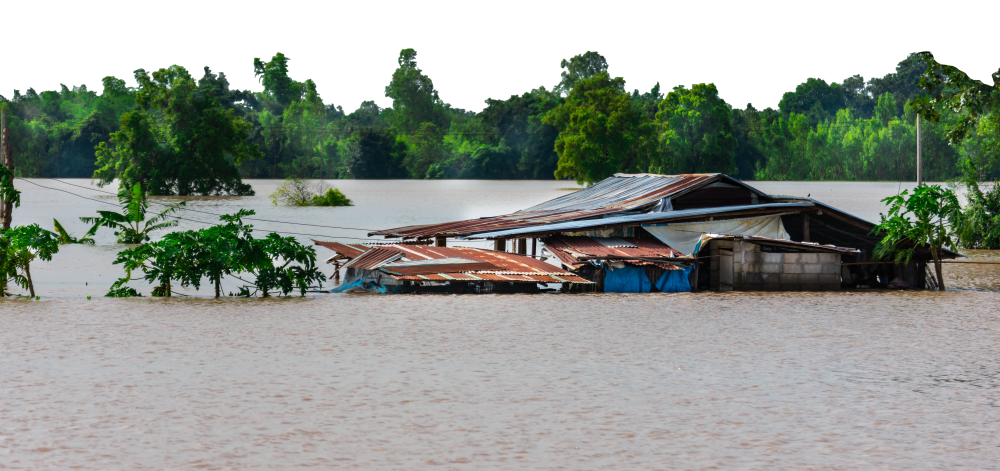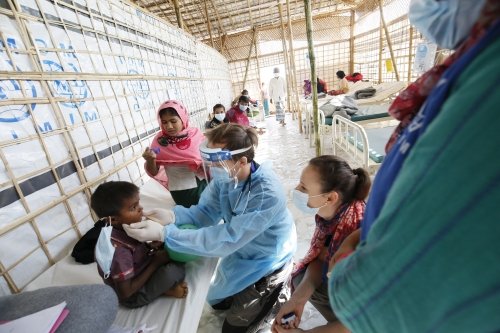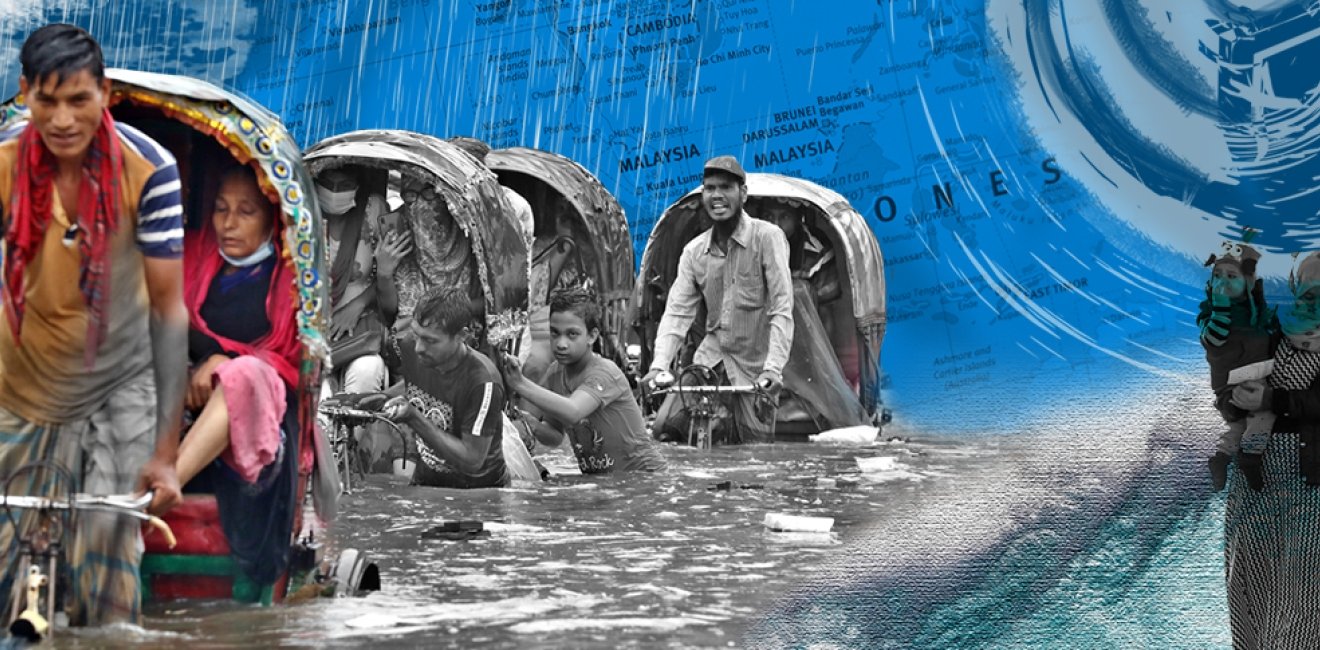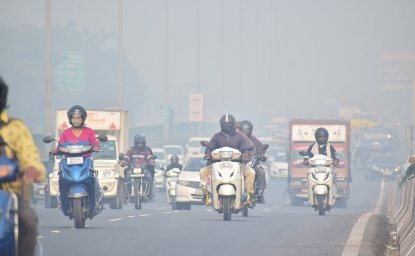In May 2020, Cyclone Amphan slammed into Bangladesh and India. It was one of the strongest storms to hit the region in decades, resulting in three million evacuees and nearly two million destroyed or damaged homes. People were displaced and lost their homes in three different countries—Bangladesh, India, and Sri Lanka. Many of the lost homes were mud huts and dilapidated shacks, and therefore not at all disaster-proof.
Cyclone Amphan is just the latest reminder that climate change effects and climate-induced migration are clear and present dangers in South Asia. Governments in the region have crafted policies that aim to mitigate these threats. However, capacity, governance, and financial constraints encumber such efforts. They are in great need of international support, which to this point has been present but insufficient.
Acute Climate Change Vulnerability
Many observers, when thinking about climate vulnerability in South Asia, reflexively fixate on Bangladesh—a low-lying, lower riparian nation often convulsed by destructive floods. In reality, the entire region is dangerously vulnerable. Rising sea levels and flooding threaten the coastal states of India, Pakistan, and Sri Lanka—as well as Bangladesh. These nations’ large and dense urban coastal populations compound the threat that climate change effects pose to their residents. Meanwhile, landlocked Afghanistan, Bhutan, and Nepal face rising temperatures, drought, and glacial melt. And the tiny yet densely populated island of Maldives—the lowest-lying country in the world—faces the real prospect of complete submersion in the not-too-distant future.
Not surprisingly, over the last decade, nearly half the region’s people—almost 700 million in all—have been impacted by at least one climate-related disaster.
In recent years, the Germanwatch think tank’s Global Climate Risk Index has ranked India and Pakistan among the top ten countries vulnerable to climate change. Additionally, a troubling new study by India’s Ministry of Earth Sciences, released in June 2020 and based on extensive climate modeling, predicts that in the coming decades India—South Asia’s most populous country by far—will become far dryer and hotter, with average temperatures poised to increase by nearly 4 degrees Celsius by century’s end. It will also experience longer monsoon periods and more glacial melt, along with warming temperatures in the Indian Ocean and predicted sea level rises of up to nearly a foot.
On the Indian Subcontinent, climate vulnerability is exacerbated by problematic public policy. In India and Pakistan, water shortages are intensified by the government’s subsidization of wasteful flood irrigation and water-guzzling crops, such as sugar. Developers and industrialists are given free rein to deplete precious water bodies. In India, communities in vulnerable neighborhoods have accused officials of ignoring flood risks—except during election campaign seasons.
Manifestations of Climate-Induced Migration
In recent years, millions of South Asians have been displaced by the effects of climate change.
Destructive weather events like Cyclone Amphan are frequent displacement triggers. Back in 2009, Cyclone Aila displaced 2.3 million in India and nearly a million in Bangladesh. Pakistan’s 2010 floods damaged or destroyed 1.1 million homes and displaced about 11 million people—and large numbers settled in major cities instead of returning home. In 2012, floods displaced 1.5 million in the Indian state of Assam. More gradual impacts can also cause displacement. In dry, rural regions, acute water shortages have caused farmers, fisher people, and others with water-dependent livelihoods to migrate to cities. This climate-induced mass displacement is compounded by two enabling factors: the large number of people who work in the agricultural sector, and densely populated coastal areas.

Most of South Asia’s climate-induced migration is domestic, from rural to urban areas. Asian Development Bank research finds that floods and agricultural land losses are increasingly contributing to decisions to migrate to major Indian cities. But cross-border migration is possible as well. Recent scholarship predicts that in Bangladesh, climate refugees from rural areas are increasingly likely to migrate internationally as Bangladeshi cities become less desirable destinations for the displaced due to population pressures and a lack of jobs.
South Asia’s high risk of climate-induced migration is particularly vivid in the Sunderbans, a UNESCO World Heritage Site that houses the world’s largest mangrove forest. Located along the Bay of Bengal and straddling areas of Bangladesh and India, it is highly susceptible to sea level rise, destructive storms, land erosion, and water salinity. Recent years have seen human flight from the Sunderbans Islands due to storms. More flight could be on the horizon given that major sectors of employment—farming, fishing, betel-leaf growing, and tourism—have been severely damaged by destructive weather events.
A 2018 World Bank study projects nearly 40 million climate migrants in South Asia by 2050 in a worst-case scenario—one in which the region suffers from a dearth of climate-friendly policies. The Bank predicts, under this scenario, that nearly a quarter of all internal migrants in South Asia—and nearly 2 percent of the overall regional population—would be classifiable as climate migrants. And even in the best-case scenario, where climate-friendly policies abound, the Bank projects nearly 20 million climate migrants by 2050. According to the Bank’s predictions, out-migration “hotspots” will range from eastern and northern Bangladesh and coastal cities in India and Bangladesh to the Delhi-Lahore corridor spanning India and Pakistan. In-migration activity will be strongest in the southern Indian highlands and areas in Nepal. Bangladesh is projected to be a regional ground zero for climate migration. Under the worst-case scenario, the country could have more than 13 million climate migrants by 2050—more than any other type of internal migrant.
Intensifying climate migration in South Asia is not only a looming humanitarian crisis—it is also a regional stability risk. Growing rural-to-urban migration will place added burdens on already-overcrowded cities to provide food, shelter, and jobs. Their inability to provide these resources could raise the risks of radicalization in a region where terrorist groups often recruit in major cities in Bangladesh, India, and Pakistan. Additionally, the mass movement of vulnerable, persecuted groups—ethnic Pashtuns fleeing floods in northern Pakistan, Muslims displaced from drought-ridden rural India, Rohingya refugees leaving flooded cities in Bangladesh—could stoke communal tensions and violence in their new communities. Furthermore, a wall that India built in the 2000s to prevent influxes of refugees from Bangladesh has led to violence, with border police gunning down several migrants trying to cross it. Surges of future climate migrants from Bangladesh could intensify this violence and deepen societal tensions in the Indian border state of Assam, where many have resented the arrival of these migrants in previous decades.
National Responses
Governments across South Asia have crafted laws and policies to mitigate climate change and climate-induced migration. And they have done so for quite some time: Back in 2005, after the catastrophic Indian Ocean tsunami, the Maldives developed a plan that envisioned relocating the population to higher ground. In more recent years, the plan has expanded to building new islands altogether.
However, these policies are hobbled by factors that range from problems with enforcement to poor infrastructure, corruption, and insufficient funding. While South Asian authorities are highly aware of climate migration risks, and they have taken initial steps to curb these risks, the magnitude of the climate change and displacement threat amplifies the region’s unpreparedness. In this regard, international support—at higher levels than at present—is essential.
Existing national responses range from the punitive (fines for those that cut down trees) to the proactive (the construction of shelters, mud and concrete walls, and embankments to protect against cyclones). There is also an impressive array of policies in place. India’s climate change national action plan promotes renewable energy, energy efficiency, sustainable agriculture (including the development of climate-resilient crops), and water management. The Mahatma Gandhi National Rural Employment Guarantee Act (MGNREGA) ensures 100 days of paid employment per financial year to manual laborers, in order to reduce migration risks stemming from climate-driven livelihood losses. And on the urban side, the Jawharlal Nehru National Urban Renewal Mission (JNNURM) has provided $10 billion to 60 major cities for infrastructure upgrades, thereby strengthening cities’ capacities to absorb climate migrants from rural areas. Additionally, micro-insurance programs have offered financial relief to disaster-affected communities in return for a modest annual premium. One of the main such programs, AfatVimo, covers damage or losses for earthquakes, floods, cyclones, and landslides.
Meanwhile, Pakistan has a climate change policy with action plans to address rural-urban migration, and a national food security policy that aims to make agriculture more resilient in the face of climate change. Bangladesh has several major initiatives expressly focused on climate migration: a National Strategy on the Management of Disaster and Climate-Inducted International Displacement, and a framework within the Ministry of Disaster Management and Relief that tackles climate-induced internal displacement. The country has also made major headway in developing the sustainable production of forest, fruit, and fish resources in coastal areas. More broadly, Bangladesh has been a pioneer in the region for its efforts to integrate climate change into the government’s interagency structure. Plans are afoot to establish a climate change agency in every government ministry, and the Planning Commission—a government advisory body—releases five- and ten-year plans on climate change.
However, the balance sheet on these signature policies is far from stellar. India’s climate change national action plan has been criticized for a lack of clear strategies and specificity. An academic assessment of NREGA finds that a lack of public awareness about the program contributes to low enrollment among rural adults. Another asserts that NREGA has strengthened economic security much more in wealthy states than rural ones. The most recent study of NREGA, released by the International Food Policy Research Institute in 2019, concludes that while it has helped boost incomes for vulnerable residents, recipients haven’t used the new income to make their farms more climate-resilient. Meanwhile, the JNNURM failed to complete many initiatives, including housing projects. It was terminated in 2014. Furthermore, government assessments of water supplies are undermined by unreliable data and poor communication between states.
Meanwhile, Pakistan’s national climate change policy boasts an implementation framework, but many climate adaptation plans haven’t been implemented. The implementing framework is also singled out for its lack of monitoring and evaluation measures. Pakistani environmentalists fault Islamabad for passing new climate-related laws instead of focusing on implementing and enforcing earlier ones. Making matters worse is that provincial officials, who have the main responsibility for implementation, often lack the technical and financial capacity to carry out climate change policy—a challenge that has afflicted Pakistani policy making more broadly ever since 2010, when a constitutional amendment devolved responsibility for many policy matters to ill-prepared provinces.
Additionally, Bangladesh, for all its success stories, still doesn’t have a national climate change policy. And its closest analogue—a climate change strategy and action plan—has struggled with budgetary and implementation challenges.
Efforts to build climate resilience in the Sunderbans—and by extension to mitigate the risk of climate-induced migration—have lagged because of problematic infrastructure. This includes water aquifers that are too deep to access, homes made of material (such as tin or asbestos) that don’t allow for rainwater harvesting, and fragile embankment structures. Other problems include poorly coordinated and communicated disaster responses and relief efforts, as well as insufficient funding for concrete installments and mangrove bio shields that would ensure more robust climate-proofing.

International Responses
There are no specific international legal frameworks related to climate-induced displacement, and there is no consensus within the international system on a definition for an “environmental refugee.” However, while there may be no legal justifications for international interventions to address “climate refugee” threats, there are compelling normative ones—and especially in South Asia, where climate vulnerability is acute and climate-induced migration is already taking place.
Fortunately, global players have already stepped in. The International Organization for Migration supported a research project between Bangladesh, Nepal, and Sri Lanka on climate and migration that resulted in a framework product on combating climate-induced migration. On more operational levels, the World Bank and the Red Cross have offered technological and scientific support for national disaster risk management programs. The Bank’s South Asia Water Initiative provides technical and analytical assistance to states to operationalize flood forecasting in the Ganges Basin. A new Bank initiative, the Climate Adaptation and Resilience for South Asia project, funds the development of climate-resilience policies and investments. Bilateral donors are involved as well; the Asia Regional Resilience to a Changing Climate program, a project of the United Kingdom’s National Weather Service and aid agency DFID, helps develop early-warning systems for climate-vulnerable communities in South Asia.
Policy Recommendations
These international efforts are encouraging, but insufficient. There is much more the global community can and should do to help reduce the risk of climate-induced migration in South Asia.
- Promote more livelihood opportunities in non-agricultural sectors. Agriculture is a top source of employment in many South Asian nations, but it is also arguably the region’s most climate-vulnerable sector. Consequently, its workers are highly susceptible to climate-driven displacement. Even while national governments aim to reduce climate threats to agriculture, the international community should help promote the growth of alternative, less climate-vulnerable employment options. Donors can fund vocational training and other skills-development programs to make the region’s millions of young people more marketable for urban-centered jobs in telecommunications, electronics, and retail, among others—all critical, high-growth-potential fields in a rapidly urbanizing region.
- Empower non-federal authorities to better tackle climate-induced displacement risks. In much of South Asia, domestic policy is a non-federal matter. However, state/provincial authorities often lack the requisite expertise and resources for this work. International donors can provide or sponsor training or other educational programs to bolster the ability of non-federal policymakers to tackle the admittedly overwhelming challenge posed by climate change and, by extension, displacement. Support for local-level authorities is particularly essential. In some South Asian nations, decentralization reforms have brought more technical and financial resources to state/provincial authorities, but these reforms often don’t extend down to local levels, where much of the on-the-ground policy implementation—including service delivery—takes place.
- Host and sponsor dialogues and other exchanges to generate greater regional cooperation, so that South Asian states can jointly combat the shared—and transnational—threats of climate change and climate-induced displacement. South Asia is rife with diplomatic tensions, thanks to longstanding strains between India and Pakistan, Pakistan and Afghanistan, and India and several smaller states. These divides are exacerbated by an absence of regional integration, thanks in great part to South Asia’s shoddy infrastructure—especially bad roads and poorly functioning electricity grids. Not surprisingly, intraregional trade is low relative to other regions, and this lack of commercial cooperation deprives the region of a potential pathway toward more trust and goodwill. Furthermore, deliberations within South Asia’s main regional organization, SAARC, are effectively paralyzed because of the tension-filled India-Pakistan relationship. Foreign diplomats and other external actors—ideally from countries perceived as neutral by all South Asian states—should convene Track II dialogues and multilateral forums to help build a region-wide consensus around a joint plan to address climate change and displacement. Some frameworks are already in place, thanks to two initiatives that have languished within SAARC for years: the Dhaka Declaration on Climate Change, which promotes capacity building and regional cooperation, and a SAARC food security reserve, which creates a food grains reserve for vulnerable communities during humanitarian disasters.
- Washington should integrate climate change mitigation assistance into its Indo-Pacific strategy, the administration’s main Asia policy. White House officials now view South Asia as a part of the Indo-Pacific region, and recent policy documents call for strengthening ties with the region under this policy—though to this point, areas of cooperation are limited to security-focused spheres such as counterterrorism and maritime collaboration. Washington should leverage the U.S. International Development Finance Corporation (DFC), a recently established American development bank that partners with the private sector, to make new investments in sustainable agriculture, disaster-resistant infrastructure, and other initiatives that can reduce the risks of climate-induced displacement. The DFC should look for corporate partners in South Asia—entities that often boast more resources and capacity than public sector interlocutors.
The Stakes of Inaction
Discussions of climate-induced migration in South Asia should not be divorced from the broader challenge of displacement. Here, the recent travails of Rohingya refugees are instructive—and a sobering reminder of the complex and tragic nexus between conflict, displacement, and climate change.
In 2017, military forces in Myanmar staged a brutal crackdown on the Rohingya, a heartbreakingly marginalized religious minority. Hundreds of thousands were displaced, and they fled next door to Bangladesh. Since then, they have toiled in overcrowded refugee camps. However, in 2019, Dhaka announced its intention to relocate up to 100,000 of them to Bhashan Char—an isolated island that is a three-hour boat ride from Bangladesh’s mainland, and that is prone to sea-level rise, storm surges, and floods. Officials initially held back, following an outcry from human rights activists, but in May 2020 nearly 300 Rohingya attempting to enter Bangladesh by sea were taken to the island. Officials cited the need to reduce the risks of COVID-19 infections within the Rohingya camps on the mainland.
First the Rohingya were displaced by conflict. Now they are at risk of being displaced by climate. And yet, if the nearly 300 souls stranded on Bhashan Char—and the thousands more that could join them—are displaced again, they will have nowhere to go.
This ongoing tragedy illustrates the seriousness of the twin threats of climate change and climate-induced migration in South Asia. It also highlights the urgency with which governments in the region, with stepped-up international support, must act to help curb these threats. And it underscores the terrible and potentially deadly costs of failing to do so.
The author would like to thank Shruti Samala and Natalia Naveed for their research assistance.
Author


Environmental Change and Security Program
The Environmental Change and Security Program (ECSP) explores the connections between environmental change, health, and population dynamics and their links to conflict, human insecurity, and foreign policy. Read more







